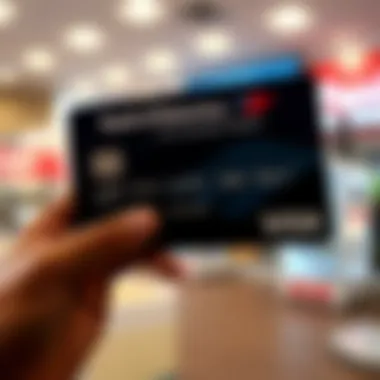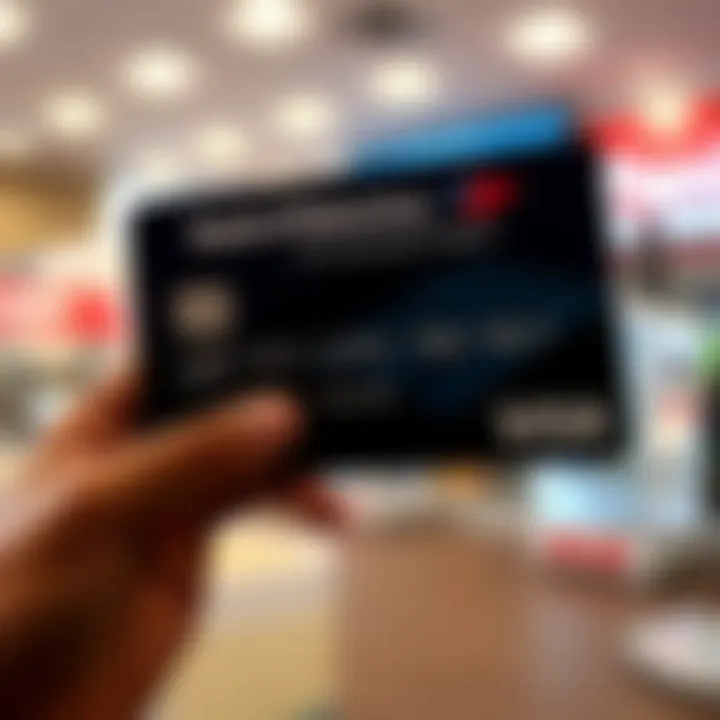Understanding the Bank of America 2.5% Cash Back Program


Intro
In today’s complex financial landscape, understanding various cash back programs can indeed feel like navigating a maze. One such option that's caught the attention of many is the Bank of America 2.5% Cash Back Program. This program isn’t just about earning money back on purchases; it’s fundamentally about how to leverage credit effectively to maximize value. As both beginner and seasoned investors dive into this cash back opportunity, having a clear roadmap can make all the difference. The nuance and breadth of this program offer numerous avenues to enhance one's financial strategy.
Whether you're filling up your grocery cart or booking a vacation, this program promises to return a portion of your expenditure back into your pocket, and who doesn’t want a little something extra for their everyday spending? Let's unpack the specifics, as understanding the ins and outs of such a program can significantly impact your financial habits and overall savings.
"Having a solid grip on your credit options can unlock doors to financial benefits you might not even know exist."
This guide aims to demystify the Bank of America 2.5% Cash Back Program and illustrate how it fits into the larger puzzle of personal finance. We'll explore the structure and benefits of the program, eligibility criteria, redeem options, and even touch upon how it stands up against competitors in the market. So grab a cup of coffee, and let’s dive in.
Overview of Cash Back Programs
When discussing rewards credit cards, cash back programs frequently hold the spotlight. They offer a tangible incentive for everyday spending, a feature that appeals to a wide range of consumers, from the occasional shopper to the avid spender. Understanding cash back programs is critical. They effectively reward users for their purchasing habits, turning routine transactions into opportunities for savings. In this landscape, the Bank of America 2.5% Cash Back Program exemplifies such rewards, making it essential to break down its components for clarity.
Understanding Cash Back Concepts
Cash back is simply a percentage of a purchase returned to the account holder, acting as a rebate of sorts. Unlike points or miles that can be more difficult to redeem, cash back translates directly into cash, often either credited back to your account or given as cash deposits. This straightforwardness enhances its attractiveness.
Despite the simplicity of the concept, there are nuanced aspects to keep in mind. For instance, not all purchases may qualify for cash back, and different categories might offer varied percentages. This brings us to consider things like tier levels and promotional periods, which can significantly influence how much one can earn over time.
How Cash Back Programs Work
Cash back programs typically function on a straightforward principle; you spend, you earn. But there is so much more than meets the eye. When you use a program like the Bank of America cash back option, you’re engaging with a system that takes into account the type of purchases you make. Here’s a general breakdown:
- Earning Rates: Many programs have tiered cashback rates depending on the category of spending. For example, grocery shopping might yield a higher percentage than general retail purchases.
- Categories: Some cards, like the Bank of America, offer rotating categories, which means you might earn 2.5% back on specific purchases only during certain times of the year. A good example is holiday shopping or back-to-school supplies, where spending tends to increase.
- Exclusions: Understand that not every transaction will earn cash back. There’s often a list of exclusions, such as payments on loans. Knowing the limitations ensures users maximize their earning potential.
- Redemption: Finally, once you've accrued cash back, knowing how to redeem it becomes essential. Options can range from direct deposits to statement credits, all of which should be considered based on individual financial strategies.
Engaging effectively with cash back programs can lead to noticeable savings over time, making the exploration of detailed offerings like Bank of America’s 2.5% program worthwhile. These rewards can serve as an essential tool, especially when strategically managed within one’s overall financial plan.
The Bank of America Cash Rewards Card
The significance of the Bank of America Cash Rewards Card cannot be overstated within the context of cash back programs. This card is structured to cater to varied consumer spending habits while providing exceptional value through its unique rewards system. Offering 2.5% cash back on specific transactions is a standout feature. This straightforward approach resonates especially well with those keen on making their purchases work in their favor. Whether one is a seasoned investor or just dipping a toe into the waters of personal finance, understanding the details of this card is vital for maximizing potential rewards.
Features of the Cash Rewards Card
The features of the Cash Rewards Card unveil an array of benefits tailored to meet the needs of diverse users. Key components include no annual fee, which makes it financially appealing for those reluctant to commit to recurring costs. Additionally, the card provides an easy-to-navigate online platform and mobile app for tracking spending and rewards. With the chance to earn 3% on a chosen category, alongside the competitive 2.5%, users can strategically leverage their spending to maximize returns. The flexibility to change the category or select additional cashback opportunities allows cardholders to adjust their earnings based on shifting spending patterns.
Earning 2.% Cash Back
Qualifying Purchases
The aspect of qualifying purchases is crucial when discussing how one earns cash back through this program. The Bank of America Cash Rewards Card offers 2.5% on any eligible purchases made outside of the selected category. This means that daily spending like groceries, gas, and even online shopping can contribute significantly to rewards accumulation. A key characteristic is the broad eligibility criteria which do not restrict rewards to niche categories. This broad approach makes it a favorable choice for consumers who prefer straightforward incentives without needing to constantly track their categories.-
When discussing the unique features of these qualifying purchases, transparency stands out as an advantage. Users know exactly what qualifies, simplifying the entire process. However, it's important to keep in mind that rewards only accumulate after the user meets a minimum threshold in their spending. This could be seen as a slight disadvantage for those who may not spend frequently or fail to track their spending meticulously.
Recurring Payments
Recurring payments represent another noteworthy aspect of how the Bank of America Cash Rewards Card can be utilized for earning cash back. Users have the opportunity to earn 2.5% for payments that recur monthly or on a fixed schedule, such as subscriptions or utility bills. This is incredibly beneficial for those who prefer a more passive approach to earning cash back. The reliability of consistent spending helps pile up rewards without requiring active engagement or decision-making from the cardholder.
A standout feature of this option is the predictability it brings into budgeting. By knowing that specific expenses will generate rewards, users can better understand their financial flow. Yet, this recurring payment dynamic could also present a caveat. Not all recurring payments may be eligible, so a careful check of what's defined as a qualifying expense is wise. Failing to ensure that the chosen recurring payment qualifies could lead to missed opportunities in cash back earnings.


Eligibility Criteria for the Program
Understanding the eligibility criteria for the Bank of America 2.5% cash back program is not just a step in the process; it’s the gateway to unlocking significant financial benefits. For anyone looking to maximize their cash back rewards, knowing who qualifies and under what conditions is paramount. It’s about aligning your financial profile with the prerequisites that Bank of America lays out, ensuring that you can reap the rewards without any missteps.
Who Can Apply?
The audience for the Bank of America cash back program is quite broad, but there are distinct qualifications that must be met. To be eligible, applicants must be at least 18 years old in most states. This age requirement is primarily in place to ensure that applicants are legally able to enter contracts, a key factor when it comes to credit cards. Residency also plays a role; applicants need to be U.S. residents or citizens.
One vital aspect is income. Bank of America often looks for a steady source of income, which reassures them about your ability to meet repayment obligations. This doesn’t mean you have to be earning a six-figure salary; even part-time jobs or annual stipends can qualify you. However, if someone just graduated from college or is entering the workforce, having a job, even one that’s part-time, can still allow them to apply. Those who have recently moved or have a less traditional employment history might want to prepare details of any financial backing or savings to bolster their application.
Additionally, having an established banking relationship with Bank of America can improve your chances. If you've been a loyal customer, with accounts ranging from savings to checking, it can add weight to your application as the bank can look at your overall financial history with them.
Credit Score Requirements
Credit score requirements are often where many applicants stumble. Generally, a credit score of 700 or above puts you in a favorable position. This score signals to the Bank of America that you have a history of managing credit responsibly. Yet, it’s essential to remember that individuals with slightly lower scores may still be considered based on other factors, such as income and credit history.
Understanding your credit report can be the first step in this dance. It’s essential to know what’s on there before applying. You might find aspects that you’d want to improve, like reducing credit card debts or resolving errors in the report itself. Checking your score can often be done for free through various platforms like CreditKarma.com or directly from the bank.
Here are some critical points to remember about credit scores and the Bank of America cash back program:
- Favorability: A score over 700 usually translates to better rates and offers.
- Flexibility: Sometimes, a lower score can still be approved based on a strong income or other significant factors.
- Credit Utilization: Keeping your usage below 30% of your credit limit can positively impact your score.
- Building Credit: If your score is below 700, consider starting with a secured credit card or a student card to build your credit history.
By understanding these criteria, not just at a surface level but with a keen eye on how they relate to your personal situation, applicants can confidently start their journey towards earning cash back rewards with Bank of America.
"The eligibility requirements act as the groundwork. Get these basics right, and the rest will follow smoothly."
For more detailed information regarding cash back programs and your credit score, you can visit Credit.com or Nerdwallet for tailored advice.
Redemption Process
Understanding the redemption process in the Bank of America 2.5% cash back program is crucial for users who want to make the most of their rewards. Knowing how to properly redeem cash back can heavily influence one’s overall financial gain. It’s not just about earning points; it’s about the strategy behind getting the most out of these rewards. Users need to consider how they can efficiently utilize their cash back to offset everyday expenses or save for future needs.
How to Redeem Cash Back Rewards
When it comes to redeeming cash back rewards from the Bank of America, there are two prominent options: account transfer and statement credits. Each method has its own characteristics that cater to different user preferences.
Account Transfer Options
Account transfer options provide a way to move cash back rewards directly to a linked Bank of America account. This feature is notably convenient for those looking to enhance their savings or checking balance. The ease of this transfer makes it a popular choice among users, as funds become immediately available.
One unique aspect of account transfers is that they can often be utilized for automatic savings plans, allowing users to gradually grow their savings over time without even lifting a finger.
"Automatically transferring rewards to your savings is like letting your money work for you while you sleep."
However, it's essential to understand that not all cash back rewards can be transferred to all account types; users should check specific terms tied to their account. In some cases, this might limit flexibility for those looking to use their cash back in various ways.
Statement Credits
On the flip side, statement credits serve as an immediate reduction of the balance on a credit card statement. This method offers a straightforward approach for those looking to lower their monthly bills. Users appreciate the simplicity of this option, as one doesn’t have to think too hard about how to apply their rewards.
One noteworthy feature of statement credits is that they can often be used to eliminate specific charges, thus giving a sense of control over personal budgets. Also, redeeming cash back this way helps prevent the temptation to mistakenly spend the funds elsewhere.


However, it's good to be aware that some restrictions may apply, especially when dealing with promotional purchases. Also, statement credits may not always contribute towards minimizing outstanding debt on the card if not done carefully.
Minimum Redemption Thresholds
When thinking about cash back rewards, it's also vital to note that a minimum threshold often exists before users can redeem their cash back. This means that not every cent earned can be claimed immediately. Having a concrete understanding of these thresholds can help users strategize their spending accordingly, ensuring that they maximize their cash back benefits over the long haul.
Fees and Limitations
When it comes to credit cards, understanding the fees and limitations associated with a cash back program is crucial for making informed financial decisions. Bank of America's 2.5% cash back program is no exception. In this segment, we will break down the essential fees and limitations that users must navigate to ensure they can maximize their rewards while avoiding unnecessary costs.
Annual Fees and Interest Rates
Annual fees are often misunderstood by many potential credit card holders. In the case of the Bank of America Cash Rewards Card, there is no annual fee. This aspect can be particularly appealing, as it allows cardholders to reap the benefits of the cash back program without losing funds to a yearly charge. It’s a breath of fresh air compared to some competitor cards where hefty annual dues can eat into your cash back rewards.
Interest rates, or the annual percentage rate (APR), are another layer to consider. Interest rates vary based on your creditworthiness and the current market. Generally, a higher credit score may lead to a lower APR, which can significantly affect how much you pay if you carry a balance. As of the latest data available, you could expect a variable APR range that may fall between 15.24% to 25.24%. This fluctuation means that if you're planning to maintain a running balance, understanding every percent matters because those fees can swell quickly.
Be mindful of the grace period—the time frame in which you can pay off your balance without incurring interest. Typically, this period is around 21 days. Take advantage of it by ensuring your payment is punctually made before the due date to maintain a pristine financial balance.
Foreign Transaction and Penalty Fees
Having your finances in order while traveling abroad is essential, and understanding foreign transaction fees plays a critical role. Unfortunately, the Bank of America Cash Rewards Card charges a fee of 3% on purchases made outside of the United States. For the globe trotter or the occasional out-of-town adventurer, this can add up. So, if you find yourself abroad frequently, weighing other card options without foreign transaction fees may be sensible.
Penalty fees can also trip up even the most careful users. The late payment fee stands at $40, and you don’t want that on your record. Missing a payment due date can result in not only penalties but also potential shifts in your credit score and APR adjustments. It’s a double whammy that can hinder your overall financial standing.
"Being informed about fees is just as important as knowing the rewards. It’s a balancing act that can tip the scales in your favor or against you."
Investigating these fees helps users reveal the true nature of their cash back program. Responsible management of a credit card can yield significant benefits, but ignorance of the underlying fees can lead to pitfalls that are less than rewarding. Consistently review your fees and stay updated. You can check out resources like Bank of America’s official site for the latest information and fine print.
Fostering knowledge regarding annual fees and interest rates alongside foreign transaction and penalty fees will significantly enhance your ability to navigate the cash back waters with confidence.
Comparative Analysis of Cash Back Programs
Understanding the nuances among various cash back programs is vital for consumers looking to maximize their rewards in today’s competitive financial environment. A comparative analysis allows users to weigh the offerings of Bank of America alongside major competitors like Chase and Discover. This examination goes beyond mere percentages and delves into the breadth of benefits, user experiences, and potential drawbacks associated with each program. By grasping these distinctions, consumers can make informed decisions tailored to their spending habits and financial goals.
Bank of America vs. Competitors
Chase Freedom
Chase Freedom stands out in the cash back arena primarily for its flexible earning structure. A notable feature of this card is its rotating categories, where cardholders earn an elevated cash back percentage on select spending categories each quarter. For example, categories may include gas stations, groceries, or dining, allowing users to adjust their spending habits accordingly to earn more. This dynamic feature is a major draw for consumers who are diligent about tracking and maximizing their spending.
However, it does come with its own set of challenges. Users need to remember to activate the bonus categories and ensure that they’re spending in those specific areas to fully benefit from the higher percentage. This can sometimes feel like a juggling act for busy individuals. All in all, Chase Freedom appeals to those who enjoy engaging actively with their credit card strategy and can appreciate the rewards structure, although it may not fit everyone’s lifestyle.
Discover It Card
On the other side of the spectrum, the Discover It Card offers a straightforward cash back program with unique features. One of its key characteristics is the cash back match for new users in their first year, effectively doubling all cash back earned. This promotion makes it an attractive choice for anyone looking to capitalize on their spending right away. Moreover, Discover’s cash back program covers a range of categories, simplifying the earning process without the need for quarterly sign-ups.
Despite these advantages, the Discover It Card does have limitations. For instance, it may not be as widely accepted globally compared to Visa or Mastercard networks. Additionally, while mainstream retailers often accept it, some users find themselves facing inconvenience at less traditional vendors. Thus, while it boasts excellent features and a user-friendly structure, the acceptance issue could turn some potential customers away.
Unique Selling Points of Bank of America
While comparing these cash back programs, it's crucial to highlight the unique advantages of the Bank of America program. Its 2.5% cash back rate on eligible purchases, combined with potential increases based on the customer’s relationship with the bank, presents a powerful incentive. Moreover, the easily navigable digital platform lets users track their rewards effortlessly, ensuring that customers stay engaged and informed about their spending rewards.


Lastly, Bank of America’s lack of an annual fee makes it appealing for less frequent users who want to enjoy cash back without the burden of recurring costs.
Strategic Considerations for Users
Navigating the landscape of cash back programs requires a clear strategy, especially when it comes to the Bank of America’s 2.5% cash back program. This section is about making the most out of the features and understanding how to approach this program with purpose.
By focusing on the strategic aspects, customers can align their spending habits with the program's benefits, maximizing rewards while minimizing costs. Knowing what to prioritize not only enhances cash back returns but also assists in establishing a responsible financial blueprint.
Maximizing Cash Back Rewards
To fully harness the potential of the 2.5% cash back program, users must track categories where spending can generate the most rewards. Receipt tracking is one practice that many credit card users ignore, yet it’s a key to success here. By keeping an eye on spending patterns, cardholders can adapt their purchasing behaviors — perhaps favoring groceries or utilities, depending on how those purchases integrate into the 2.5% cash back structure.
Engaging with the program’s dedicated features such as bonus categories, where additional incentives are offered during specific periods, can further increase the total cash earned. Staying informed through Bank of America’s communications about changing categories can lead to strategic buying decisions, ensuring that every dollar spent counts.
Using the Card Intelligently
Tracking Spending
Tracking spending plays a pivotal role in managing any rewards program effectively. With Bank of America's features, users can utilize their online banking tools to monitor transactions. This contributes significantly to understanding where money goes and identifying potential areas of improvement.
The interface for these tools allows users to categorize purchases, making it straightforward to visualize spending habits. By turning spending into data, users can modify their habits to hit important milestones, like increased cash back for certain expenses.
Key characteristics of tracking spending include:
- Data-driven insights: Detailed breakdowns of spending categories.
- Sets goals: Helps users create specific targets for cash back earnings.
However, one must also consider the risk of overspending in a drive for rewards. A balance needs to be struck to prevent unnecessary purchases just to earn cash back, ensuring that the strategy remains sound.
Setting Up Alerts
Setting up alerts can create a safety net for cash back management. Users can configure notifications for various triggers, such as when spending hits predetermined amounts or when bonus categories activate.
These alerts serve as gentle nudges in the direction of better financial practices and ensure that users don’t miss out on potential earning opportunities. It’s a proactive strategy that keeps users engaged and informed without overwhelming them.
Unique features of setting up alerts include:
- Timely notifications: Ensures you’re always aware of your spending status.
- Customization: Users can tailor alerts to fit their unique financial landscape.
On the downside, if users are inundated with too many notifications, there's the risk of ignoring them altogether. Therefore, it’s critical to choose alerts that genuinely facilitate better spending habits without cluttering the mind.
Ending and Future Trends
In concluding this exploration of the Bank of America 2.5% cash back program, it is vital to focus on its significance within the wider arena of cash back credit cards. Cash back programs are increasingly becoming a popular choice for consumers who seek to maximize their spending potential, reflecting broader trends in consumer behavior and financial strategies. With the rise of online shopping and digital payments, reward systems like these are more relevant than ever. By understanding the particulars of this program, cardholders can better leverage their purchases for financial benefits.
Evaluating the Program's Longevity
The longevity of the Bank of America cash back program hinges on several factors, such as user satisfaction, market competition, and economic conditions. One critical element is how well the program evolves to meet changing consumer needs. For instance, if cardholders are increasingly inclined towards travel rewards instead of cash back, the bank may need to adapt to retain its customer base. While the 2.5% rate is competitive now, external factors such as economic recessions or shifts in consumer spending habits could affect its attractiveness.
Moreover, user experiences can significantly influence the sustainability of this program. Feedback from consumers regarding ease of redemption, customer service, and overall benefits will play a significant role in determining whether the program remains a favorite among bank customers. With growing competition from alternatives like the Chase Freedom card or the Discover It Card, it is essential for Bank of America to continually enhance their offerings and maintain engagement with their user base.
The Evolution of Cash Back Offerings
As we look to the future, cash back offerings are also evolving. Historically, many programs provided fixed percentages on all purchases, but now, companies are segmenting their rewards based on spending categories. For instance, certain purchases like groceries or gas could yield higher cash back rates, which is something many consumers find attractive.
Digitization is now influencing how these programs are structured. With mobile banking applications and financial tech, users can track their cash back in real-time, enhancing engagement. Enhanced data analytics allow banks to offer personalized rewards tailored to clients' spending habits, thus addressing their specific interests and preferences.
"The landscape of cash back credit cards is likely to evolve continually, keeping pace with changes in consumer behavior and technological advancements."



